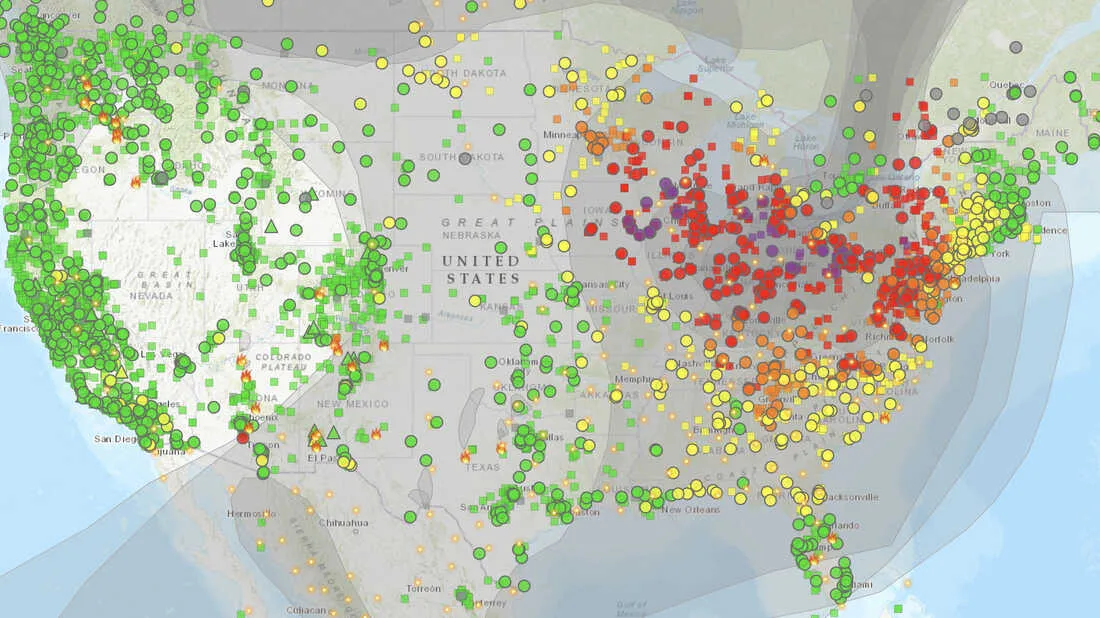Smoke From Canadian Wildfires Approaches the Northeast
As the summer begins to settle in, residents of the northeastern United States are once again facing the consequences of wildfire smoke drifting in from Canada. The air quality, already a troubling factor in many communities, is further compromised as numerous wildfires burn across the Canadian landscape. Maine’s Department of Environmental Protection (DEP) has issued air quality alerts for Wednesday and Thursday, signaling a pressing message: the smoke is here, and it might become part of our new summertime normal.
The Current Situation
Early in the week, the DEP indicated that conditions were ripe for unhealthy air quality due to the accumulation of smoke particles in the atmosphere. Wildfires, particularly rampant during dry seasons, release harmful pollutants, such as particulate matter (PM2.5), into the air. This has several health implications, especially for groups such as children, the elderly, and people with preexisting respiratory conditions.
Air quality maps, many of which are continuously updated, are showing alarming levels of pollutants in parts of Maine and surrounding states. Residents have reported noticing a haze in the sky, a tell-tale sign of smoke intrusion that can lead to numerous health complications including respiratory issues, eye irritation, and even long-term cardiovascular problems.
Why Are We Seeing More Wildfires?
The rise in wildfire frequency and intensity can be attributed to a combination of factors, primarily climate change and its impact on weather patterns. Higher temperatures and prolonged drought conditions create a perfect environment for wildfires to ignite and spread. Reports indicate that regions in Canada have experienced near-record levels of dry spells, resulting in an increased number of wildfires this season.
In addition to climate change, forest management practices also contribute to the likelihood of wildfires. Over time, lands that are not properly managed can accumulate dry debris and dead vegetation, providing ample fuel for wildfires when ignited.
The Implications of Smoke in the Atmosphere
As smoke from wildfires settles in urban and suburban areas, the diminishing air quality poses immediate health concerns. According to air quality experts, exposure to wildfire smoke can have acute effects, including:
- Respiratory problems: Smoke inhalation can inflame lung tissues, making it difficult to breathe.
- Cardiovascular concerns: The particulate matter can enter the bloodstream, leading to further complications.
- Eye and throat irritation: Smoke-induced irritation can lead to discomfort and increased susceptibility to infections.
Long-term exposure to unhealthy air quality can exacerbate existing health issues and contribute to new chronic conditions. The intricate web of connections between air quality and public health is becoming increasingly evident as more studies surface, linking wildfires to rising healthcare costs and decreased quality of life.
Maine’s Response to the Air Quality Crisis
In light of the impending air quality issues, Maine’s DEP is urging residents to minimize outdoor activities and to remain indoors when possible. Special emphasis is placed on vulnerable populations, including individuals with respiratory illnesses, children, and the elderly, who may be at greater risk from poor air quality conditions. The DEP has also recommended the following:
- Keep windows and doors closed to prevent smoke from entering homes.
- Use air purifiers if available, particularly those equipped with HEPA filters.
- Monitor local air quality reports frequently to stay updated.
These protective measures aim to ensure citizens can safeguard their health amidst the increasing presence of wildfire smoke in the region.
The Future of Summer Air Quality
As we continue to grapple with the seasonal influx of smoke from wildfires, the question remains: will this trend become our new normal? Experts agree that the frequency of wildfires will increase due to climate change and other factors. This means that communities across the Northeast must adapt to an environment where hazardous smoke may become an annual summertime occurrence.
This new reality could necessitate long-term public health strategies, with increased funding for air quality monitoring and public awareness campaigns. Many cities may also have to explore new infrastructure solutions to better protect residents, such as improved air filtration systems in schools and public places.
Community Preparedness and Resilience
Building community resilience is critical in facing the challenges posed by wildfire smoke. Local governments and organizations can play a pivotal role by fostering preparedness initiatives that equip residents to deal with these disturbances effectively. Public education campaigns could highlight the importance of air quality awareness and promote community-level responses to natural disasters and health threats.
Moreover, local health departments should prioritize outreach programs that inform residents about the potential long-term risks associated with wildfire smoke exposure. Workshops and information sessions can help communities understand how to prepare and respond to worsening air quality, especially in the context of climate change.
Looking Ahead
As the summer progresses, it remains crucial to monitor air quality and stay informed about the status of ongoing wildfires. With proper communication, public health initiatives, and a focus on climate resiliency, communities can adapt to this daunting new normal while preserving the health and safety of their residents.
In summary, the smoke from Canadian wildfires serves as an urgent reminder of our changing climate and the direct impact it has on our day-to-day lives. This summer, as smoke approaches the Northeast, it will be on all of us to stay informed, prepared, and proactive in the face of this growing environmental challenge.







